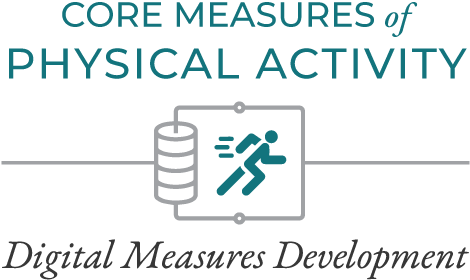
How to use digital measures of physical activity for Clinical Researchers
Physical activity (PA) is an important indicator of health. Patients with a variety of diagnoses clearly report that physical activity is critical to their quality of life. New therapies that can slow the worsening of, maintain, or improve aspects of physical activity are of great value to patients.

Why use digital measures of physical activity?
-
Patients report physical activity as essential to their quality of life and ability to maintain independence and dignity.
-
Compared to in-clinic assessments, digital measures of physical activity provide more granular data on a patient’s physical activity in daily life contexts that matter most to them.
-
Digital measurement can expand patient access to participation as well as diversity in clinical trials.
Get started using these resources to incorporate the right digital measure(s) of physical activity in your clinical trial
- Identify opportunities where digital measurement can fill gaps and provide value. Define the problems you are trying to solve. For example:
- Is there a lack of relevant assessments of physical activity for your patient population of interest, or are there gaps with current clinic-based test/s?
- Does your portfolio and pipeline have a high technical failure rate and are there opportunities to leverage new measures of physical activity that are more sensitive to change and reflective of patients’ daily lives?
- Are there challenges screening participants for your trials or recruiting the necessary number of participants needed to determine efficacy?
- Define goals and objectives of using digital measures of physical activity to address this/these problem(s) in your clinical trial.
- Select digital measure(s) of physical activity from the core set, based on:
- (1) prioritization of the most important aspects of physical activity that are meaningful, as described by patients in the qualitative research, and/or
- (2) measures where there is already evidence to support use in the patient population (search DATAcc by DiMe’s Library of Digital Measurement Products and Analytical Validation Library)
- Implement candidate digital measures of physical activity as exploratory or secondary endpoints in clinical trials early on, such as in pilot studies and non-pivotal studies.
- Use results of earlier phase trials to support inclusion of selected digital physical activity endpoints in later-stage studies (e.g., as primary or secondary endpoints in pivotal studies) to further validate the selected digital measure(s) of physical activity for a specific patient population and context-of-use (see decision tool).
- Perform necessary research – and engage with regulatory colleagues early and often – to ensure regulatory acceptance of the digital PA measure as an endpoint to support a label claim, and/or use of digital PA measure in post-market settings (see decision tool).
- Use the relevant Measurement Dossier to ensure you’ve documented evidentiary requirements for use of selected digital measure(s) of physical activity as endpoints.
- Search the Library of Digital Measurement Products for existing tools that assess your measure of interest.
- Secure documentation of verification, analytical validation, and clinical validation (V3); assess usability in your study population; evaluate whether the technology meets security requirements; and ensure specific data rights and governance of technologies. Use this checklist to guide the selection of a fit-for-purpose DHT.
- Develop a procurement plan, data plan, and protocol.
- Ensure an inclusive approach to your clinical trial design.
Step Into Action: Adopting core measures of physical activity in drug development
Clara Reacher is a clinical research scientist at a pharma company and is testing a new drug going into a phase IIB trial, treating patients with chronic heart failure (CHF) experiencing moderate to severe symptoms of breathlessness and fatigue. She is looking to incorporate a digital measure of physical activity, based on patient reports that persistent symptoms of CHF limit their physical activity, which significantly impedes their quality of life.
Qualitative research revealed that patients with CHF desire the ability to walk continuously, and to have the independence to do house chores, walk through the grocery store, and participate in activities they enjoy, like strolling around the park with a friend (see CHF patient quotes below). Demonstrating this relationship is a key part of FDA’s Patient-Focused Drug Development (PFDD) Guidance.
“I try to grocery shop. […] there are so many times when I actually have to go sit down, because I can’t make it all the way through the shop.”
“That I cannot walk and exercise much, has made me feel that I lack something” … and “It makes me upset that I am always at home.”
‘‘Before this heart attacked me … I enjoyed my life outdoors very much. Now, only walking from room to room around the office makes me tired.”
Note: Quotes sourced from a systematic review of qualitative studies conducted by DATAcc’s PA project team.
Based on the qualitative research completed by the DiMe Physical Activity project team, Clara considers digital measures related to ambulation that represent walking volume: “number of walking bouts at specified bout durations” and “step count.” She also considers “time spent in moderate to vigorous physical activity,” but since her patients rarely get to these PA intensity levels, this measure is ultimately not selected.
Following the decision tool below, Clara documents clinical evidence of the use of “number of walking bouts at specified bout durations” and “step count” tested in patients with CHF.
She develops a plan to incorporate these two measures as secondary endpoints, using the measurement dossier to ensure evidentiary requirements are documented. She also searches for digital health technologies (DHT) capturing these two measures and uses DiMe’s checklist to select a fit-for-purpose DHT. Throughout the entire process, Clara uses DATAcc by DiMe’s toolkit to ensure inclusive deployment of digital measurement products in the clinical trial.
If the results of the phase IIB trial show that these two measures are sensitive to change and reduce sample sizes and/or timelines, Clara will advocate for their implementation in further trial phases to support their use as endpoints or screening tools within her organization (i.e., to decision-makers/execs).
Following these steps can support clinical decision-making and enable Clara to collect evidence needed to advocate for use of digital endpoints within her team to motivate further champions. She is able to select the most appropriate outcome(s) from the core set of digital clinical measures of physical activity and understand next steps to ensure she sets her team up for the greatest regulatory success, and returns the most value to her organization and most importantly, the patients who will benefit from effective therapeutics.

Clara’s goals:
- Incorporate digital PA measures which are meaningful to patients with chronic heart failure in daily life into clinical trials, consistent with regulatory recommendations for patient-focused drug development
- Cost-saving: decrease timelines and patient sample sizes
- Arrive at accurate outcomes, reflecting efficacy of therapy
- Communicate the adoption and implementation of digital endpoints to clinical teams effectively
Some challenges Clara may have to navigate through:
- Gaining support and buy-in from decision-makers and other clinical team members
- Disrupting clinical workflows, facing adherence to the status quo, and hesitancy to adopt digital measures without certainty that the endpoints can detect signal
- Investment of time, training, human resources, and money to implement digital health tools in clinical trial research
- Uncertainty of acceptance from regulators
